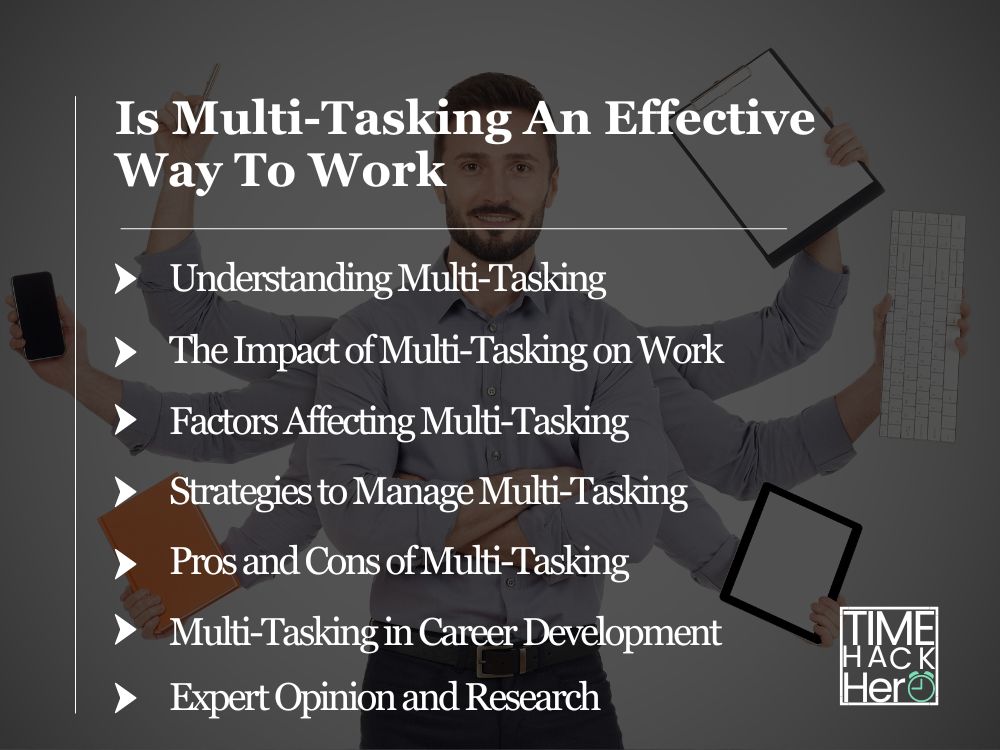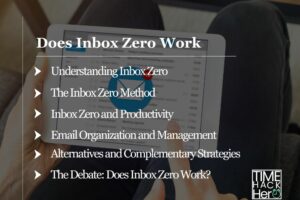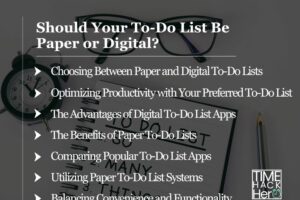In today’s fast-paced work environment, most individuals believe multitasking is the key to increasing productivity. Juggling tasks such as answering emails, attending meetings, and organizing workloads seems like an efficient way to accomplish more within limited timeframes. However, several studies and experts question multitasking’s actual effectiveness, arguing that it could hinder overall performance and brain health.
First, it’s crucial to understand that the human brain lacks the ability to perform multiple tasks simultaneously. When we think we’re multitasking, we’re actually just switching quickly between tasks, potentially compromising productivity and focus. Focusing on a single task at a time is a more effective approach for several reasons, such as reducing errors and improving overall task quality.
Furthermore, multitasking can lead to negative impacts on work-life balance and wellness. Overloading the brain with too many tasks can contribute to mental exhaustion and burnout. Consequently, conquering the myth of multitasking and prioritizing single-tasking can play a significant role in improving daily productivity and efficiency.
Table of Contents
Understanding Multi-Tasking
Cognitive Processes
Multi-tasking involves dividing attention between different tasks, which can place demands on our cognitive processes. Attention is a limited resource, and when we attempt to allocate it to multiple tasks simultaneously, we may not be able to fully engage in each task, leading to reduced performance and potentially detrimental effects on overall efficiency. Moreover, as our brains are, to a great extent, designed for single-task focus, multitasking can lead to cognitive overload and increased stress levels.
Task-Switching
Task-switching, a key element of multitasking, refers to the act of alternating between different tasks in rapid succession. While it may give the illusion of being more productive, research from the American Psychological Association has shown that switching from one task to another can actually take more time and decrease overall productivity. This is due to the “switching costs” associated with re-engaging one’s cognitive processes and refocusing attention on each new task.
Media Multitasking
Media multitasking, or engaging with multiple media streams simultaneously (e.g., watching TV while checking email), is a subset of multitasking. While it is prevalent in today’s digital age, studies have shown that media multitasking can negatively impact cognitive functioning and learning. Such activities can divert attention, reduce comprehension, and impair retention of information, ultimately making it harder to accomplish more complex tasks.
In summary, multitasking, whether through task-switching or media multitasking, can place a strain on cognitive processes and attention resources. By understanding the limitations and potential drawbacks of multitasking, individuals can adjust their strategies to manage tasks more effectively and enhance productivity.
The Impact of Multi-Tasking on Work
Productivity and Efficiency
Studies have shown that multi-tasking takes a toll on productivity as our brains are not designed to perform multiple tasks at the same time. Instead of effectively managing simultaneous tasks, we quickly switch from one task to another, leading to decreased efficiency. When focusing on a single task, individuals tend to achieve better results, as it allows them to fully concentrate on the task at hand and make better use of available cognitive resources.
Mistakes and Errors
- Multi-tasking is known to increase the risk of mistakes and errors, as constantly switching between tasks consumes mental effort.
- Due to these task-switching costs, the quality of work produced during multi-tasking is often lower compared to when focusing on a single task.
- Examples of negative effects of multi-tasking on work include incorrect data entry, missed deadlines, and miscommunication with colleagues.
Effect on Creativity
Multi-tasking can negatively impact creativity in the workplace. When constantly switching between tasks, it is difficult to dive deep into the creative process or to dedicate sufficient cognitive resources to the generation of new ideas. In contrast, focusing on one task at a time allows the mind to fully engage with the problem or project, fostering a more innovative atmosphere.
Factors Affecting Multi-Tasking
Environment
The immediate environment in which an individual works can have a significant impact on their ability to multitask. A cluttered or noisy workspace may reduce the ability to focus on multiple tasks, leading to decreased productivity. On the other hand, a clean and organized workspace can help improve focus and make it easier to switch between tasks. Additionally, minimizing distractions such as background noise, visual clutter, and interruptions can help improve multitasking abilities.
Busyness and Anxiety
The level of busyness and anxiety an individual experiences can also affect multitasking effectiveness. When a person is extremely busy or under high stress, their ability to focus on multiple tasks simultaneously may be diminished. This can lead to less efficient work and even reduced brain health, as switching between tasks can take a toll on productivity (Verywell Mind). To counteract this, it is essential to manage stress and strike a balance between work and personal life to improve focus and productivity.
Technology Use
Technology can either aid or hinder multitasking depending on how it is utilized. On one hand, technological tools such as productivity apps, email, and messaging systems can facilitate communication and information sharing, making it easier for individuals to juggle multiple tasks. However, overreliance on technology may contribute to information overload, leading to counterproductive multitasking. For instance, constantly checking email or social media notifications can be distracting and draw attention away from other important tasks. To optimize technology use for effective multitasking, it is crucial to prioritize tasks and minimize unnecessary distractions.
Strategies to Manage Multi-Tasking
Scheduling and Prioritizing
It’s essential to create a schedule to manage multiple tasks effectively. Using a daily to-do list can help you stay focused on your priorities. Allocate specific time blocks for each task, considering their deadlines and importance. Omit any unnecessary tasks and arrange them in a logical order. To prioritize your tasks, you can use methods like the Eisenhower Matrix or the ABCDE method.
–Eisenhower Matrix: Categorize tasks into four quadrants based on urgency and importance. –ABCDE method: Assign a letter (A, B, C, D, or E) to a task based on its priority level.
Focus and Mindfulness
Maintaining focus is critical when managing multiple tasks. Minimize distractions in your environment by silencing notifications or using noise-cancelling headphones. Taking regular breaks and practicing mindfulness techniques, such as deep breathing or meditation, can also enhance your focus and concentration.
–Pomodoro Technique: Work in 25-minute intervals with 5-minute breaks to boost productivity and maintain focus. –Meditation: Spend a few minutes daily practicing mindfulness to reduce stress and improve concentration.
Setting Goals and Deadlines
Establishing clear goals and deadlines can help you manage your tasks more effectively. Begin by setting SMART (Specific, Measurable, Achievable, Relevant, and Time-bound) goals to ensure you’re working with clear objectives. Assign deadlines for each task and track your progress regularly. Collaborate and communicate with your team members to clarify objectives and ensure alignment in goals.
Here’s a table summarizing the strategies mentioned above:
| Strategy | Method/Tips | Benefits |
|---|---|---|
| Scheduling | – To-do list | – Clarity and organization |
| – Time blocks | – Efficient time management | |
| Prioritizing | – Eisenhower Matrix | – Focus on important tasks |
| – ABCDE method | – Increased productivity | |
| Focus | – Pomodoro Technique | – Improved concentration |
| – Meditation | – Reduced stress | |
| Goals and Deadlines | – SMART goals | – Clear objectives |
| – Team communication | – Team alignment |
Pros and Cons of Multi-Tasking
Multi-tasking is the act of performing more than one task or activity simultaneously. It’s a common concept in our busy lives and can have both positive and negative effects on our work, productivity, and overall well-being. Here are some of the advantages and disadvantages of multi-tasking:
Pros:
- Boosts brainpower: Engaging in multiple tasks helps keep the brain active and focused, potentially increasing mental stamina over time (Indeed.com).
- Adaptability: Multi-tasking can make us more adaptable and capable of handling a diverse range of tasks and situations.
Cons:
- Reduced productivity: Contrary to popular belief, multi-tasking can actually hinder productivity. When we attempt to perform multiple tasks simultaneously, we are more likely to become distracted and switch between tasks, resulting in decreased overall efficiency (Verywell Mind).
- Higher risk of errors: Juggling multiple tasks at once can lead to a higher likelihood of making mistakes, as our attention is split between various activities.
- Mental strain: Multi-tasking can cause increased mental fatigue, as our brains are constantly switching between tasks and trying to keep up with the constant demand (APA).
- Impaired focus: Attempting to concentrate on multiple tasks can result in a lack of focus on each individual task, making it difficult to complete any of them efficiently (Forbes).
In summary, multi-tasking can have some potential benefits such as boosting brainpower and improving adaptability. However, it is crucial to weigh these advantages against the potential drawbacks, including decreased productivity and added mental strain. Finding a balance between focusing on single tasks and trying to manage multiple responsibilities simultaneously will likely yield the best results for most individuals.
Multi-Tasking in Career Development
Team Dynamics
Multi-tasking can have both positive and negative effects on team dynamics. On one hand, an employee who can juggle multiple tasks simultaneously might coordinate well with team members, delegate or contribute to multiple projects at once, and reduce project completion times.
However, multi-tasking can also lead to reduced focus and hinder in-depth communication within a team. As research shows, our brains are not equipped to perform multiple tasks at the same time. Instead, we switch quickly between tasks, which can reduce effectiveness and productivity. A team that encourages single-task focus may see improved communication, thoroughness, and overall success.
Skill Development
In terms of skill development, multi-tasking can provide opportunities for improvement in specific areas such as time management, prioritization, and adaptability. These are valuable skills in any career. Developing these skills can make employees more versatile and efficient in managing their workloads.
However, it is essential to strike a balance between multi-tasking and focusing on individual tasks. Overemphasis on multi-tasking may hinder an employee’s ability to deepen their expertise in a specific area or skill. Thus, an effective strategy for career development would involve combining multi-tasking with periods of focused, single-task work in order to cover both skill development and team dynamics aspects.
In summary, multi-tasking in career development can be both an asset and a hindrance, depending on how it is managed. By finding the right balance between multi-tasking and focused work, employees can develop valuable skills while maintaining positive team dynamics and ensuring long-term career growth.
Expert Opinion and Research
Cleveland Clinic Study
A study conducted by the Cleveland Clinic reveals the impact of multitasking on productivity. According to this research, our brains are unable to perform multiple tasks simultaneously. Instead, what we perceive as multitasking is often just rapid switching between tasks. Ultimately, this constant switching takes a toll on productivity, making it less effective than focusing on a single task at a time.
Homework and Multi-Tasking
In the context of homework and academic tasks, multitasking has been shown to have negative effects on clarity and overall performance. When students attempt to juggle multiple assignments or combine homework with other activities, such as social media or entertainment, their attention and working memory are often compromised. This leads to reduced cognitive flexibility and ultimately affects their ability to comprehend the subject matter effectively.
When it comes to homework, it is recommended that students:
- Focus on one task at a time
- Avoid distractions, such as social media and entertainment
- Allocate separate time to different subjects for better retention and understanding
With these strategies, students can maintain a higher level of productivity and comprehension, ultimately promoting better academic performance.









